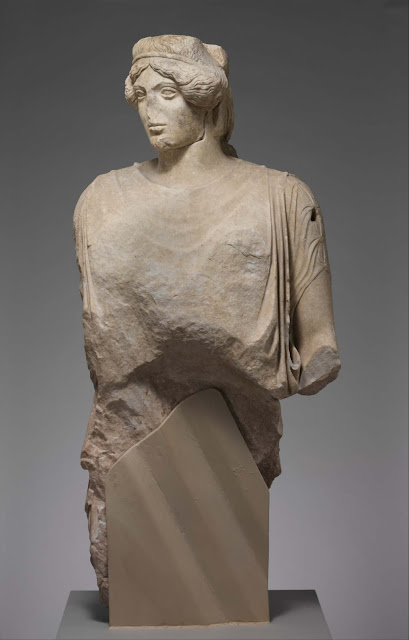 |
| Portrait of a mother Fragment of marble funerary altar with pediment AD 120-130 Rome Metropolitan Museum of Art |
 |
| General with Corinthian Helmet Marble copy of 4th century BC Greek bronze 1st-2nd century AD Rome Metropolitan Museum of Art |
"Roman sculpture cannot be examined in isolation. It was an integral part of everyday life and was exhibited in public places like fora, basilicas, temples, theaters, and baths. ... Roman art was not art for art's sake. Even Roman replicas of famous Greek originals were valued more as reflections of a patron's refined Hellenic taste than as works in their own right. Public portraits celebrated the virtues and accomplishments of those they represented or were arranged in groups that associated the honorand with an illustrious predecessor or an eventual heir. Private portraits were, at least at first, an integral part of ancestral veneration." – from Roman Sculpture / by Diana E.E. Kleiner. (Yale University Press, 1992)
 |
| Sarcophagus Carved marble with figures of Theseus & Ariadne AD 130-150 Rome Metropolitan Museum of Art |
"We could pass over in silence the truly countless number of sarcophagi if their artistic value was to be the sole criterion. These stone coffins are almost without exception works from the imperial period. ... Only in a very few of these monuments can the treatment of individual details be described as good; in many of them it is only moderate, and in the great majority wretched." – Jakob Burckhardt writing in 1855
 |
| Dancing Maenad Marble copy of 5th century BC Greek relief 27 BC-AD 14 Rome Metropolitan Museum of Art |
 |
| Calyx Krater as Garden Urn Carved marble with dancing Maenads 1st century AD Rome Metropolitan Museum of Art |
 |
| Statue of a Youth Marble copy after 5th century BC Greek bronze 1st century AD Rome Metropolitan Museum of Art |
 |
| Statue of seated man Marble copy after 2nd century BC Greek statue 1st century BC Rome Metropolitan Museum of Art |
 |
| Sarcophagus Carved marble with contest between Muses & Sirens 3rd century AD Rome Metropolitan Museum of Art |
"Winkelmann's idealistic vision of Greek art is largely responsible for the fact that, with a few exceptions, from his day right down to our own times sarcophagi have played only a small role as ancient works of art. For his classical taste, the sarcophagi of the late second and third centuries, with their expressive manner and abundance of figures, were evidence of late-period style gone to seed. ... Modern Impressionist and Expressionist art have given us new ways of seeing, and as a result have completely changed our aesthetic appreciation of later sarcophagus art. We are no longer fixated on neatly arranged, classical composition; we can make a connection between the sharp contrasts in proportions and in the relief, the excessive number of images, and the unsystematic way we take in large surfaces where the eye has to jump, as it were, with aesthetic experiences that have positive connotations in today's art." – from Living with Myths : the Imagery of Roman Sarcophagi / Paul Zanker and Bjorn C. Ewald (Oxford University Press, 2012)
 |
| Statue of Eirene (personification of Peace) Marble copy after 4th century BC Greek statue AD 14-68 Rome Metropolitan Museum of Art |
 |
| Athena Marble copy after 5th century BC Greek statue 1st-2nd century BC Rome Metropolitan Museum of Art |
 |
| Sarcophagus fragment Carved marble with death of Meleager mid-2nd century AD Rome Metropolitan Museum of Art |
 |
| Ceremonial Pillar Carved marble with twining snake and wreath 1st-2nd century AD Rome Metropolitan Museum of Art |
"This pillar may be either votive or sepulchral. The snake is both an attribute of the healing god Asklepios, suggesting this object may been a thank offering on behalf of one cured of an illness, and a potent symbol of the underworld, alluding perhaps to a funereal function. The wreath, meanwhile, evokes victory in the broadest sense, as well as the realm of Dionysos, whose mythological rebirth makes his iconography particularly appropriate in a tomb context." – Metropolitan Museum curator's notes